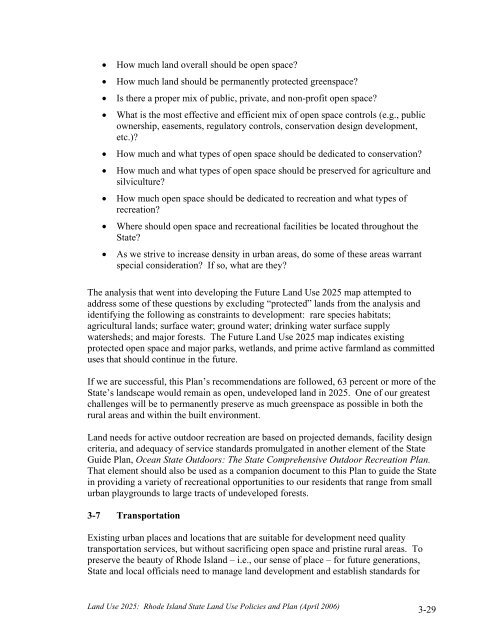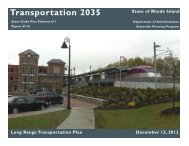Land Use 2025 - RhodeMap RI
Land Use 2025 - RhodeMap RI
Land Use 2025 - RhodeMap RI
- No tags were found...
You also want an ePaper? Increase the reach of your titles
YUMPU automatically turns print PDFs into web optimized ePapers that Google loves.
• How much land overall should be open space?• How much land should be permanently protected greenspace?• Is there a proper mix of public, private, and non-profit open space?• What is the most effective and efficient mix of open space controls (e.g., publicownership, easements, regulatory controls, conservation design development,etc.)?• How much and what types of open space should be dedicated to conservation?• How much and what types of open space should be preserved for agriculture andsilviculture?• How much open space should be dedicated to recreation and what types ofrecreation?• Where should open space and recreational facilities be located throughout theState?• As we strive to increase density in urban areas, do some of these areas warrantspecial consideration? If so, what are they?The analysis that went into developing the Future <strong>Land</strong> <strong>Use</strong> <strong>2025</strong> map attempted toaddress some of these questions by excluding “protected” lands from the analysis andidentifying the following as constraints to development: rare species habitats;agricultural lands; surface water; ground water; drinking water surface supplywatersheds; and major forests. The Future <strong>Land</strong> <strong>Use</strong> <strong>2025</strong> map indicates existingprotected open space and major parks, wetlands, and prime active farmland as committeduses that should continue in the future.If we are successful, this Plan’s recommendations are followed, 63 percent or more of theState’s landscape would remain as open, undeveloped land in <strong>2025</strong>. One of our greatestchallenges will be to permanently preserve as much greenspace as possible in both therural areas and within the built environment.<strong>Land</strong> needs for active outdoor recreation are based on projected demands, facility designcriteria, and adequacy of service standards promulgated in another element of the StateGuide Plan, Ocean State Outdoors: The State Comprehensive Outdoor Recreation Plan.That element should also be used as a companion document to this Plan to guide the Statein providing a variety of recreational opportunities to our residents that range from smallurban playgrounds to large tracts of undeveloped forests.3-7 TransportationExisting urban places and locations that are suitable for development need qualitytransportation services, but without sacrificing open space and pristine rural areas. Topreserve the beauty of Rhode Island – i.e., our sense of place – for future generations,State and local officials need to manage land development and establish standards for<strong>Land</strong> <strong>Use</strong> <strong>2025</strong>: Rhode Island State <strong>Land</strong> <strong>Use</strong> Policies and Plan (April 2006)3-29
















